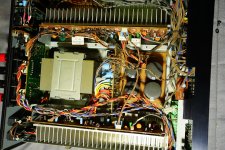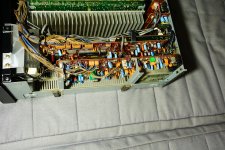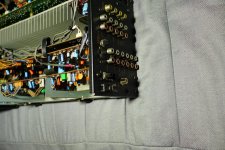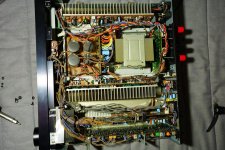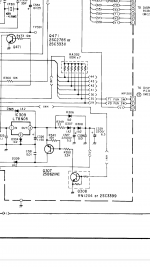Good afternoon.
I have luxman r115. From what I read it's supposed to be generous In bass. But there is almost no bass lower than 60hz.
My set up 2 bw lcr600 s3 speakers
And bw 800asw ported sub.
I use high level inputs to connect subwoofer. I do have power amp and pre amp running these speakers. But once In a while buy integrated amps to play with.
So adcoms, nakamichi, nad, harman I series receivers i had before provide plenty of bass.
Basically when speakers and sub are plugged into luxman subwoofer is barely moving. Turning bass knob just ads more bass to speaker output..
If I use luxman as pre amp (it has 2 pairs of preouts)
I get a little better bass response. But still not rich.
I've heard that some nakamichi power amps (pa-5) had few capacitors that rolled off low end at 50hz.. anything like this on luxman r115. I am not a bass head.. just surprised at lack of it.. it's like running big speakers with 5.1 hdmi 5 lbs receiver
Upper frequencies , upper midrange are stellar. Outrageously detailed.
I have luxman r115. From what I read it's supposed to be generous In bass. But there is almost no bass lower than 60hz.
My set up 2 bw lcr600 s3 speakers
And bw 800asw ported sub.
I use high level inputs to connect subwoofer. I do have power amp and pre amp running these speakers. But once In a while buy integrated amps to play with.
So adcoms, nakamichi, nad, harman I series receivers i had before provide plenty of bass.
Basically when speakers and sub are plugged into luxman subwoofer is barely moving. Turning bass knob just ads more bass to speaker output..
If I use luxman as pre amp (it has 2 pairs of preouts)
I get a little better bass response. But still not rich.
I've heard that some nakamichi power amps (pa-5) had few capacitors that rolled off low end at 50hz.. anything like this on luxman r115. I am not a bass head.. just surprised at lack of it.. it's like running big speakers with 5.1 hdmi 5 lbs receiver
Upper frequencies , upper midrange are stellar. Outrageously detailed.
Also I noticed that this receiver uses Robicon capacitors. Are they cheap scrap metal?
In the past recapping onkyo amps with all elna silmic ii added significant amount of bass. Onkyo mostly use nichikon blue capacitors.
In the past recapping onkyo amps with all elna silmic ii added significant amount of bass. Onkyo mostly use nichikon blue capacitors.
Rubycon capacitors are not cheap scrap metal and Luxman didn't tarnish their reputation for quality audio by fitting them. Rubycon also created the Blackgates legend, FWIW. Run through your imaginary list of recognized good Japanese electrolytic cap. brands and add it the rest, such as Elna, Nichicon, Panasonic, United Chemicon and more.
If they are the original parts though, they'll be 26 years young, somewhat past their prime and likely having some affect on bass frequencies, which demand the highest power, particularly without the augmenation of the sub.
Have you tried the line level input(s) for the subwoofer? The amplifier has 2 sets of stereo pre-out connections available. One stereo RCA-RCA connector lead should do the trick of delivering the lowest frequencies possible, direct from the preamp. I think, from looking at the sub's low-level input connectors, that these will match up fine.
The high level inputs are intended to be driven by the satellite speaker cables. i.e from the main L&R channel power outputs but this is a 2nd rate arrangement. If the feed is band-limited by the power amplifier, you may get some sub-bass attenuation there, as I doubt the Luxman was ever designed to drive subwoofers in the manner of present-day home theatre systems. https://www.manualslib.com/manual/888427/Bowers-And-Wilkins-800asw.html?page=4#manual
If you have full power and bandwidth from your satellite speakers when connected direct to the amplifier in a simple stereo arrangement, there may be a problem in the subwoofer itself or just the low pass crossover frequency and level settings.
If they are the original parts though, they'll be 26 years young, somewhat past their prime and likely having some affect on bass frequencies, which demand the highest power, particularly without the augmenation of the sub.
Have you tried the line level input(s) for the subwoofer? The amplifier has 2 sets of stereo pre-out connections available. One stereo RCA-RCA connector lead should do the trick of delivering the lowest frequencies possible, direct from the preamp. I think, from looking at the sub's low-level input connectors, that these will match up fine.
The high level inputs are intended to be driven by the satellite speaker cables. i.e from the main L&R channel power outputs but this is a 2nd rate arrangement. If the feed is band-limited by the power amplifier, you may get some sub-bass attenuation there, as I doubt the Luxman was ever designed to drive subwoofers in the manner of present-day home theatre systems. https://www.manualslib.com/manual/888427/Bowers-And-Wilkins-800asw.html?page=4#manual
If you have full power and bandwidth from your satellite speakers when connected direct to the amplifier in a simple stereo arrangement, there may be a problem in the subwoofer itself or just the low pass crossover frequency and level settings.
Last edited:
Thanks a lot for looking into this..
I will definitely try connecting the sub using one extra pair of pre outs on this receiver. Kind of did not think about it.
I powered this system with 35w/chanel nakamichi ta-1a(all elna caps inside)
Harman kardon 380i..also around 30w/channel.
Bass was in abundance
I could feel the sub shaking.
I thought using high level inputs was the prefered way to run a sub. Is it not? The other reason is that high pass filter is 80hz on this sub when using high level inputs. And those lcr600 s3 bookshelves sound much cleaner when they are not overburdened by frequencies lower than 80hz.
Hm yes I dont know much about capacitors) of course circuitry may have bigger impact on bass and sound. But I've heard rumors that elna silmic ii boost bass responce.
Are there any rough guidelines on what various capacitors do to tremble, bass. Maybe there are Some particular flavours in each line/brand of capacitors.
I am planning to keep luxman r115 till I die.. or preferably till i find r117.
I think I'll do a complete recap of r115. Wanted to know which caps are better to use.
I will definitely try connecting the sub using one extra pair of pre outs on this receiver. Kind of did not think about it.
I powered this system with 35w/chanel nakamichi ta-1a(all elna caps inside)
Harman kardon 380i..also around 30w/channel.
Bass was in abundance
I could feel the sub shaking.
I thought using high level inputs was the prefered way to run a sub. Is it not? The other reason is that high pass filter is 80hz on this sub when using high level inputs. And those lcr600 s3 bookshelves sound much cleaner when they are not overburdened by frequencies lower than 80hz.
Hm yes I dont know much about capacitors) of course circuitry may have bigger impact on bass and sound. But I've heard rumors that elna silmic ii boost bass responce.
Are there any rough guidelines on what various capacitors do to tremble, bass. Maybe there are Some particular flavours in each line/brand of capacitors.
I am planning to keep luxman r115 till I die.. or preferably till i find r117.
I think I'll do a complete recap of r115. Wanted to know which caps are better to use.
Questions about recap of luxman r115. What do I really need to recap
I am mostly using luxman as a pre amp or an amplifier. Radio will never be used. Tone controls too almost never.
Looking from the top left to right first two boards are attached to hear sinks. .
The next smaller board looks like video input and output board. The next larger board is cd, phono, tape input board. And the rightmost is tuner board.
I am mostly using cd input In cd straight mode. Don't use record players..
Basically I am only interested in replacing caps responsible for pre amp and power amp sections of this receiver.
Would it be safe to say that I just need recapping 2 big boards attached to heat sinks and few capacitors on board of speaker jacks/inputs.
Audio input board seems like a chore to take out.. and I don't use tone controls..so was hoping I could skip it.
I attached some images.
I am mostly using luxman as a pre amp or an amplifier. Radio will never be used. Tone controls too almost never.
Looking from the top left to right first two boards are attached to hear sinks. .
The next smaller board looks like video input and output board. The next larger board is cd, phono, tape input board. And the rightmost is tuner board.
I am mostly using cd input In cd straight mode. Don't use record players..
Basically I am only interested in replacing caps responsible for pre amp and power amp sections of this receiver.
Would it be safe to say that I just need recapping 2 big boards attached to heat sinks and few capacitors on board of speaker jacks/inputs.
Audio input board seems like a chore to take out.. and I don't use tone controls..so was hoping I could skip it.
I attached some images.
Attachments
Also a quick question. What capacitors would boost bass response. Anything to stay away from?
Big caps are nichikon 2 8200uf 71v and 2 8200 63v.
Would going up in capacity hurt much. What if I use 8200uf but 80v all around
Sofar I found nichikon lks series.
And briefly Google kemet.. first few decriptions are along the lines of "wow waw.. ground braking. This is it"
How important is it to use audio grade caps as opposed general purpose say dishwasher capacitors when it comes to big capacitors
Big caps are nichikon 2 8200uf 71v and 2 8200 63v.
Would going up in capacity hurt much. What if I use 8200uf but 80v all around
Sofar I found nichikon lks series.
And briefly Google kemet.. first few decriptions are along the lines of "wow waw.. ground braking. This is it"
How important is it to use audio grade caps as opposed general purpose say dishwasher capacitors when it comes to big capacitors
Capacitor leakage current. Importance.
Sorry to post threads every few minutes.
Basically I am ordering caps for luxman r115.
There is one weird capacitor on pre amp section. 22000uf 5.5v rated. Nichikon.
Mouser and digikey have few options 22000 uf 6.3v.
I thought nichikon kw and fw series were higher end stuff.
Now I noticed KA line which is a bit more expensive than FW KW caps. The difference between KA capacitor is current leakage is 4uA(t rating is 105c) While on FW and KW it's around 4000uA. (T rating 85c)
Another difference is that KW,FW caps riple current is 1000mA higher
I assume smaller leakage Is an upgrade.. improvement. Am I right?
This is the cap I am looking to buy.
http://www.mouser.com/Search/m_Prod...WHP%2bVUsh2b6rQ4T7fWpBJZnbzcsyP2a4/0F5XsA0w==
These are the other caps. KW ,FW lines.
http://www.mouser.com/Search/m_Prod...6tj4v8Cko68PAXIlAPzGD49OT5IgbF8CTyR8MfLr3Aw==
Sorry to post threads every few minutes.
Basically I am ordering caps for luxman r115.
There is one weird capacitor on pre amp section. 22000uf 5.5v rated. Nichikon.
Mouser and digikey have few options 22000 uf 6.3v.
I thought nichikon kw and fw series were higher end stuff.
Now I noticed KA line which is a bit more expensive than FW KW caps. The difference between KA capacitor is current leakage is 4uA(t rating is 105c) While on FW and KW it's around 4000uA. (T rating 85c)
Another difference is that KW,FW caps riple current is 1000mA higher
I assume smaller leakage Is an upgrade.. improvement. Am I right?
This is the cap I am looking to buy.
http://www.mouser.com/Search/m_Prod...WHP%2bVUsh2b6rQ4T7fWpBJZnbzcsyP2a4/0F5XsA0w==
These are the other caps. KW ,FW lines.
http://www.mouser.com/Search/m_Prod...6tj4v8Cko68PAXIlAPzGD49OT5IgbF8CTyR8MfLr3Aw==
Last edited:
In regard to the the active filtering used in subwoofers, bear in mind that the filter and the controls (the subwoofer processor) are the same by either connection method. The signal input to the subwoofer is either picked off from the speaker leads or the preamplifier and the impedance differences and levels are compensated for by a suitable input attennuator. Some reasons that speaker leads might be considered inferior as the signal source, are that they are prone to interference, RFI and EMR, which is a growing concern in a world shifting to cheap, lightweight switched mode power supplies. Other matters are the filtering effect and added noise of the power amplifier itself plus the extra connections and wiring for the satellite leads which audiophiles will turn up their noses to.
There is no indication in the service or user manuals of the subwoofer, that there is anything different about the speaker level or line level filtering. It is a variable low-pass filter that determines only what the sub. "hears". It has no effect on the power amplifier's normal, full range output to the satellite speakers. This is the same for the vast majority of powered subwoofers, whether they are up-market B&W products or el-cheapo brand.
You might want to think about how the sub. could control the rolloff at the power required to drive the satellites. If they did roll off the bass response at 80 Hz or whatever, it would mean adding a very large highpass passive filter (at least a large coil and resistor) in the speaker leads and this would not suit any and all possible speakers that users may hook onto the terminals. If it were an active filter instead, another stereo power amplifier would be required in the subwoofer box and that would be nuts, as you already have your preferred one in play.
Some folk get a kick out of recapping but once done, it's like any maintenance job - even changing tyres on your car. It's not a trivial operation though, if done fully and systematically. Check the types specified carefully - some smaller ones in the preamp and power amps may be non-polarized (NP or BP marked with no identifying negative terminal stripe), rather than simple electrolytics.
Changing brands of caps won't change the amount of bass you hear. The factors behind the amount of bass are the actual capacitance values and the internal resistance of the cap and these are all related to the value and grade of cap chosen. All the major manufacturers offer several ranges of caps that suit the various applications in audio amplifiers. However, there are always folk who prefer brand X, grade Y because of their limited experience and insecurity when not following the crowd but usually the simple act of replacement with a new and suitable grade is all that's needed to bring on the smiles of happiness. It's only when the beginners compare brands, like cars again, that everyone becomes an expert on the latest trending products.
Good luck with the recap - follow the service manual specification of the caps as far as possible and take great care not to damage the PCB by prolonged heating and peeling of the copper foil. The cap grades specified though, are now probably obsolete or quite different (shrunk) since 1990. You will need to check equivalent types, pin spacings, heights etc. in almost all cases. This linked manual site is free but requires registration: https://www.hifiengine.com/manual_library/luxman/r-115.shtml
There is no indication in the service or user manuals of the subwoofer, that there is anything different about the speaker level or line level filtering. It is a variable low-pass filter that determines only what the sub. "hears". It has no effect on the power amplifier's normal, full range output to the satellite speakers. This is the same for the vast majority of powered subwoofers, whether they are up-market B&W products or el-cheapo brand.
You might want to think about how the sub. could control the rolloff at the power required to drive the satellites. If they did roll off the bass response at 80 Hz or whatever, it would mean adding a very large highpass passive filter (at least a large coil and resistor) in the speaker leads and this would not suit any and all possible speakers that users may hook onto the terminals. If it were an active filter instead, another stereo power amplifier would be required in the subwoofer box and that would be nuts, as you already have your preferred one in play.
Some folk get a kick out of recapping but once done, it's like any maintenance job - even changing tyres on your car. It's not a trivial operation though, if done fully and systematically. Check the types specified carefully - some smaller ones in the preamp and power amps may be non-polarized (NP or BP marked with no identifying negative terminal stripe), rather than simple electrolytics.
Changing brands of caps won't change the amount of bass you hear. The factors behind the amount of bass are the actual capacitance values and the internal resistance of the cap and these are all related to the value and grade of cap chosen. All the major manufacturers offer several ranges of caps that suit the various applications in audio amplifiers. However, there are always folk who prefer brand X, grade Y because of their limited experience and insecurity when not following the crowd but usually the simple act of replacement with a new and suitable grade is all that's needed to bring on the smiles of happiness. It's only when the beginners compare brands, like cars again, that everyone becomes an expert on the latest trending products.
Good luck with the recap - follow the service manual specification of the caps as far as possible and take great care not to damage the PCB by prolonged heating and peeling of the copper foil. The cap grades specified though, are now probably obsolete or quite different (shrunk) since 1990. You will need to check equivalent types, pin spacings, heights etc. in almost all cases. This linked manual site is free but requires registration: https://www.hifiengine.com/manual_library/luxman/r-115.shtml
It's this c327 capacitor. Part of the circuit is shown.. is it of any major importance?
Any normal level of leakage shouldn't be important in this circuit.
The KA certainly seems to be a better part, though.
Last edited:
Any normal level of leakage shouldn't be important in this circuit.
The KA certainly seems to be a better part, though.
Extremely cool. Would u also chime in on skipping tuner board? would be logical to assume that a board with antena ground, am loop, 75oHm fm antena is a tuner section and has nothing to do with pre amp and power amp sections.
Really appreciate. . Getting closer and closer to clicking place order button
would be logical to assume that a board with antena ground, am loop, 75oHm fm antena is a tuner section
Sure sounds like a tuner to me.
Correction: I should have said 'large capacitor and resistor' for a highpass filter, above.
You might find this introduction to RC filters helpful, though the choice of title "passive" filter circuits is misleading, as the same RC circuit elements can be used in active or passive applications: Passive Filter Circuits
Though more serious, this article is about subwoofers in general and should spark some interest as will the many other DIY and educational articles about filters and much more on the ESP website. Good reading: The Subwoofer Conundrum
You might find this introduction to RC filters helpful, though the choice of title "passive" filter circuits is misleading, as the same RC circuit elements can be used in active or passive applications: Passive Filter Circuits
Though more serious, this article is about subwoofers in general and should spark some interest as will the many other DIY and educational articles about filters and much more on the ESP website. Good reading: The Subwoofer Conundrum
Correction: I should have said 'large capacitor and resistor' for a highpass filter, above.
You might find this introduction to RC filters helpful, though the choice of title "passive" filter circuits is misleading, as the same RC circuit elements can be used in active or passive applications: Passive Filter Circuits
Though more serious, this article is about subwoofers in general and should spark some interest as will the many other DIY and educational articles about filters and much more on the ESP website. Good reading: The Subwoofer Conundrum
Hi Ian.. thanks for these article recommendations. I really like this sub. sometimes i'd like an option of high pass filter at say 120 or 60. i believe it has a capacitor and a resistor high pass filter at 80hz. i may be reading it wrong but on page 15 of the manual it mentions high pass filter. 1st order.
https://www.manualslib.com/manual/888427/Bowers-And-Wilkins-800asw.html?page=15#manual
but thats when i get to removing amplifier from the sub for recap and hopefully adding 2 more high pass filter options.
i've done about 5 complete recaps of few onkyo preamps, integrated amps. NAD 3140. few times made a mistake of buying BP capacitors. in some parts of the circuit i heard it's ok or even beneficial to use BP instead of polar. but again it's advices from other novices.
i decided to hold off on experimenting and trying various set ups with r115 until i completely recap this receiver. i sometimes need to run 2 power amps. and 2 pairs of pre outs is something i've been looking for for a long time) besides i really like the sound. i never thought ill have an integrated amp that is capable of delivering sound quality of system of separates. just ordered all caps
i got it all wrong with the sub. you are completely right.. speakers receive 80hz+ signal only if line level connecting method is used. )) if speaker level is used speakers receive full range signal it looks like. i've used speaker level for about 8 months now.. ) glad switched to line level.
Had a look at the R-115 service manual. Btw, you should get one to save and print.
www.vintageshifi.com/repertoire-pdf/pdf/telecharge.php?pdf=Luxman-R-115-Service-Manual.pdf
Receivers are a different breed from power amps or integrated, particularly because they have too many stages for the signal to go through. The R-115 is no different there.
Caps are not responsible for not having low bass. They may be for not having a good audio quality, but nothing else. At the time this receiver was released (1988), caps were not yet pointed as good or bad according to type.
But first of all I would study the signal path and see what you can bypass with a wire. In my case I never use equalizing, so I bypass all that.
Then you might start with caps quality, particularly on the line preamp and power amp. Phono too if you use it.
Just a comment on bypolars. Bateman's testing on caps considered them the best of electrolytics when in the signal path. Particularly two in series.
www.vintageshifi.com/repertoire-pdf/pdf/telecharge.php?pdf=Luxman-R-115-Service-Manual.pdf
Receivers are a different breed from power amps or integrated, particularly because they have too many stages for the signal to go through. The R-115 is no different there.
Caps are not responsible for not having low bass. They may be for not having a good audio quality, but nothing else. At the time this receiver was released (1988), caps were not yet pointed as good or bad according to type.
But first of all I would study the signal path and see what you can bypass with a wire. In my case I never use equalizing, so I bypass all that.
Then you might start with caps quality, particularly on the line preamp and power amp. Phono too if you use it.
Just a comment on bypolars. Bateman's testing on caps considered them the best of electrolytics when in the signal path. Particularly two in series.
Last edited:
What you are looking for is called a "goldcap". 0.022 mF 5.5 V is a fairly small one, they make these in values up to 1 F (no typo)... not like I'd recommend going this big, but if you can only find a 0.047 mF that would be fine, too. These serve as standby power backup to retain station memory for weeks or months.
Weird to have C329 after the goldcap. Excessive leakage on that one could surely suck the goldcap empty. Wouldn't hurt to uprate the voltage of this a bit, and make sure it's not the most leaky series ever to begin with.
Weird to have C329 after the goldcap. Excessive leakage on that one could surely suck the goldcap empty. Wouldn't hurt to uprate the voltage of this a bit, and make sure it's not the most leaky series ever to begin with.
These serve as standby power backup to retain station memory for weeks or months.
Yes, if this is a tuner board then the leakage would be important.
Use low leakage, 105C, and higher voltage caps then.
 Your threads have been merged. Please note that starting multiple threads on the same topic is against the forum rules.
Your threads have been merged. Please note that starting multiple threads on the same topic is against the forum rules. Sorry to post threads every few minutes.
Basically I am ordering caps for luxman r115.
WOW.. this thread is a huge mess now. Who would want to even look at it. Random posts about everything in random order.
Posting quick update.
After recapp and about 50 hours of play time.. not much changed. Yes there is a tad bit more bass. But still this r115 does not sound like a 70 watts per channel amp.
Clarity is of course extreme) the amount of detail is insane. I never thought an integrated amp can best separates system. This is the only one in this respect.
As far as bass. . Kind of weak. A 35watt/channel nakamichi ta-1a sounds bigger than luxman. I am still keeping luxman. Good as preamp. Not many pre amps can reviel that much detail. It actually is more detailed than yamaha cx-1 (1200$ pre amp) . But unfortunately very thin bass in luxman. Best for midrange /tweeter amplification. Need a sub for sure.
Posting quick update.
After recapp and about 50 hours of play time.. not much changed. Yes there is a tad bit more bass. But still this r115 does not sound like a 70 watts per channel amp.
Clarity is of course extreme) the amount of detail is insane. I never thought an integrated amp can best separates system. This is the only one in this respect.
As far as bass. . Kind of weak. A 35watt/channel nakamichi ta-1a sounds bigger than luxman. I am still keeping luxman. Good as preamp. Not many pre amps can reviel that much detail. It actually is more detailed than yamaha cx-1 (1200$ pre amp) . But unfortunately very thin bass in luxman. Best for midrange /tweeter amplification. Need a sub for sure.
- Status
- Not open for further replies.
- Home
- Amplifiers
- Solid State
- Luxman r115 r-115 thin bass.. problem or design ?
